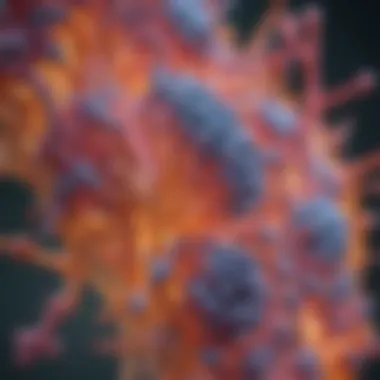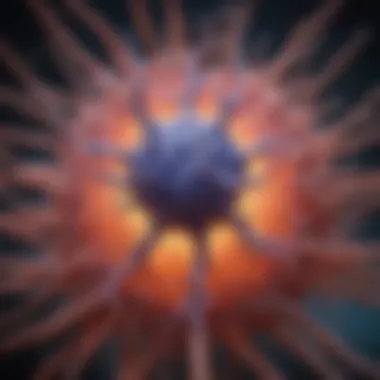Glycosylation Enzymes: Mechanisms and Implications


Intro
Glycosylation is a critical biochemical modification that occurs post-translationally on proteins and lipids. This process is not merely a decorative addition; it serves pivotal roles in cell signaling, immune response, and various other biological functions. At the heart of glycosylation are glycosylation enzymes, which catalyze the transfer of sugar moieties to target substrates. Understanding these enzymes reveals insights into their mechanisms and implications in health and disease.
Glycosylation enzymes, including glycosyltransferases and glycosidases, play intricate roles in modifying glycan structures. Each enzyme operates under specific conditions, indicating a finely tuned system responsible for maintaining cellular functionality. Abnormalities in these enzymes can lead to extensive consequences, such as impaired immune responses and altered cell communication pathways, highlighting their importance in biological systems.
In this article, we delve into the complexities of glycosylation processes, examining the mechanisms by which glycosylation enzymes operate and their far-reaching implications for health and disease. By exploring individual classes of glycosylation enzymes, we aim to uncover their specific functions while providing an understanding of their broader relevance to cellular physiology.
Research Highlights
Overview of Key Findings
- Glycosylation enzymes are integral to the modification of proteins and lipids.
- They influence critical cellular processes such as signaling and immune responses.
- Impairments in glycosylation can lead to disease states, including cancer and genetic disorders.
- The interaction between enzymes and substrates is crucial for proper biochemical pathways.
Significance of the Research
The research surrounding glycosylation enzymes is significant for several reasons. First, it enhances our understanding of fundamental cellular processes. Second, it provides insights into pathological conditions associated with glycosylation disorders. This research can inform the development of therapeutic strategies by targeting specific enzymes involved in these pathways.
"Understanding glycosylation enzymes offers a window into the complex networks that govern cellular health and disease."
Original Research Articles
Summary of the Article
This section provides a concise summary of notable research articles that explore the various facets of glycosylation enzymes. These articles collectively shed light on the mechanisms of action, substrate specificity, and the implications of enzymatic activity on biological systems.
Author Contributions
The research articles highlight contributions from various authors, each bringing expertise in different aspects of biochemistry, genetics, and molecular biology. This collaboration fosters a comprehensive understanding of glycosylation's role in health and disease, emphasizing the multidisciplinary nature of the field.
Prolusion to Glycosylation Enzymes
The landscape of biochemistry is populated with myriad processes that sustain life. Among these, glycosylation stands as a pivotal modification influencing protein function and cell communication. Understanding glycosylation enzymes is crucial. These enzymes not only facilitate the addition of sugar moieties to proteins and lipids but also significantly impact a wide range of biological functions. The complexity and specificity of glycosylation processes create a rich area for research and applications, particularly in health and disease.
Definition of Glycosylation
Glycosylation is the enzymatic process whereby carbohydrate groups are covalently attached to proteins or lipids, forming glycoconjugates. This post-translational modification can change the physical and chemical properties of biomolecules, thus influencing their stability, localization, and function. Principally, glycosylation is categorized into two main types: N-linked and O-linked. N-linked glycosylation involves the attachment of oligosaccharides to nitrogen atoms on asparagine residues, whereas O-linked glycosylation pertains to the attachment to oxygen atoms on serine or threonine residues. The precision of these processes is governed by specific glycosylation enzymes, highlighting the essential role they play in biochemical pathways.
Importance of Glycosylation in Biological Systems
Glycosylation serves as a major determinant in various biological events. It is indispensable for the proper folding and stability of proteins. Moreover, glycosylation impacts receptor recognition and signaling pathways, fundamental in cellular communication. Notably, it plays a role in immune responses, by marking glycoproteins for recognition by immune cells and influencing their activity. Abnormal glycosylation patterns can signal underlying pathologies, such as cancer or autoimmune disorders, indicating how intimately connected this process is to health and disease.
The intricate relationship between glycosylation and cellular functions underscores the need for in-depth exploration of glycosylation enzymes.
In summary, a robust comprehension of glycosylation enzymes lays the groundwork for further inquiry into numerous biochemical phenomena. This article will delve deeply into the types of glycosylation enzymes, their mechanisms of action, and their clinical implications, providing a comprehensive overview of this critical biological process.
Types of Glycosylation Enzymes
Understanding the types of glycosylation enzymes is crucial for grasping the varying functions and mechanisms in glycosylation processes. These enzymes play pivotal roles in the dynamic modification of proteins and lipids through the addition of carbohydrate structures. This section will cover three main classes of glycosylation enzymes: glycosyltransferases, glycosidases, and sialyltransferases. Each type has distinct biochemical activities that contribute to diverse biological outcomes.


Glycosyltransferases
Glycosyltransferases are a broad class of enzymes responsible for the transfer of sugar moieties (glycans) from nucleotide sugar donors to specific acceptor molecules. They are involved in the synthesis of glycoproteins and glycolipids, affecting their structure and function. Glycosyltransferases can be categorized based on their substrate specificity and the type of glycosidic bond they form.
These enzymes are essential for various cellular processes. They influence cell signaling pathways, modulate immune responses, and determine cellular recognition events. Alterations in their activity have been implicated in several diseases, highlighting their significance in both health and pathology.
Glycosidases
Glycosidases, also known as glycoside hydrolases, serve a different function. They hydrolyze glycosidic bonds, leading to the removal of sugar residues from glycan structures. This activity is necessary for protein degradation, cellular recycling, and metabolic processes. Glycosidases ensure that glycoproteins maintain their structural integrity and functionality by trimming excessive or improperly attached sugar groups.
The regulation of glycosidases is tightly controlled, as their malfunction can result in disorders such as lysosomal storage diseases. Thus, understanding glycosidases is essential for elucidating their roles in cell biology and medicine.
Sialyltransferases
Sialyltransferases are a specialized subgroup of glycosyltransferases. They add sialic acid residues to glycan structures, profoundly impacting protein functionality. Sialic acid plays a crucial role in modulating interactions between cells and their environment. It protects glycoproteins from degradation and influences cell-cell recognition.
The activity of sialyltransferases can determine the sialylation patterns of glycoproteins, with significant implications in tumor biology and immune response. By understanding sialyltransferases, researchers can develop targeted therapies for diseases where glycosylation abberations are prevalent.
The classification of glycosylation enzymes into these types highlights their individual and collective importance in the intricate landscape of glycobiology. It emphasizes their relevance to various biological functions and potential implications in disease states.
Mechanism of Glycosylation
Understanding the mechanism of glycosylation is essential for comprehending how glycosylation enzymes function within biological processes. Glycosylation serves as a critical post-translational modification that affects a wide range of molecular interactions and cellular outcomes. This modification enables proteins and lipids to adopt specific roles in various physiological pathways, thereby influencing health and disease states. The way these enzymes work directly affects metabolic pathways, signaling cascades, and overall cellular communication.
Substrates of Glycosylation Enzymes
Glycosylation enzymes act on specific substrates to facilitate the transfer of sugar moieties. The primary substrates include proteins, lipids, and nucleic acids. In the case of proteins, these may be glycoproteins, where the presence of glycan structures communes essential information regarding protein stability and functionality. For lipids, glycosylation can modify membrane properties, affecting signal transduction and cellular localization.
The different types of substrates are influenced by the structure of the glycan chains, which can vary in composition and branching, ultimately affecting the interactions between molecules. Substrates together with the enzymes act as a dynamic duo, ensuring the precise execution of biological functions. Substrates include:
- Proteins
- Lipids
- Nucleic Acids
These variations contribute to the diversity of glycosylation patterns across various organisms and tissues.
Catalytic Mechanisms
The catalytic mechanisms of glycosylation enzymes are vital for facilitating the attachment and modification of glycan structures. Generally, this involves nucleophilic attack where a sugar donor molecule reacts with the substrate, forming a glycosidic bond. Two main classes of enzymes are responsible for this process: glycosyltransferases and glycosidases.
- Glycosyltransferases are responsible for adding sugar moieties, whereas
- Glycosidases remove these sugar units.
The efficiency of glycosylation reactions can be influenced by several factors, including enzyme specificity, substrate availability, and cellular conditions.
This catalysis is not a random process; it is tightly regulated and ensures that the specific glycosylation patterns are produced needed for cellular needs.
Regulation of Enzymatic Activity
The regulation of glycosylation enzymes is crucial for maintaining cellular homeostasis and responding to internal and external stimuli. Enzymatic activity is controlled by various mechanisms. These mechanisms include:
- Allosteric regulation, where the binding of a molecule at a site other than the active site changes enzyme activity.
- Post-translational modifications which also directly alter enzyme function.
- Environmental factors like pH and temperature, which can significantly affect enzyme stability and activity.


Together, these regulatory mechanisms ensure that glycosylation is adjusted according to cellular needs. For example, during stress or disease conditions, the patterns of glycosylation may change, revealing the consequent need for more or less activity from specific enzymes. This regulation can have profound implications in the context of disease, emphasizing its critical role in health.
Glycosylation Patterns and Cellular Functions
Understanding glycosylation patterns is crucial for grasping how glycosylation enzymes influence cellular functions. Glycosylation, while often overlooked, plays a significant role in determining the fate of proteins and lipids within biological systems. The specific arrangement and types of sugar residues transferred onto these molecules not only affect their structure but also drive their interactions and functions in the cellular environment.
The impact of glycosylation on protein folding and stability, cell signaling pathways, and cell-cell interactions reflects the complexity of cellular communication. Each glycosylation event can alter protein dynamics, signaling efficiency, and even immune responses.
Impact on Protein Folding and Stability
Glycosylation has a profound influence on protein folding and stability. Proteins must achieve a specific structure to perform their intended cellular functions, and glycosylation can assist in achieving this conformation. By adding carbohydrate moieties, glycosylation can stabilize proteins against degradation and misfolding, thus enhancing their functional lifespan. An appropriate glycan structure ensures that proteins are correctly folded and recognized by other cellular components. A breakdown in this process can lead to diseases such as cystic fibrosis, where misfolded proteins accumulate.
In summary, the glycosylation pattern can determine whether a protein is functional or prone to aggregation.
Role in Cell Signaling Pathways
Cell signaling pathways are fundamental for maintaining cellular homeostasis and responding to environmental stimuli. Glycosylation critically modulates these pathways. Specific glycan structures can act as recognition signals for receptors, guiding complex cascades of biochemical events. For instance, the presence of certain sialic acid residues on cell surfaces can protect cells from immune recognition, influencing the outcomes of signaling events.
Moreover, glycosylation can affect how receptors interact with their ligands, consequently refining the sensitivity and specificity of cell signaling. This aspect means that even minor changes in glycosylation patterns can have extensive repercussions at the signaling level, impacting processes such as cellular growth, differentiation, and apoptosis.
Influence on Cell-Cell Interactions
Cell-cell interactions form the bedrock of tissue organization and function. Glycosylation contributes to these interactions by influencing the adhesion and communication between cells. For example, selectins are glycoproteins that mediate the binding of leukocytes to activated endothelium. The specific glycan structures on these selectins dictate their binding affinity and specificity.
Additionally, glycosylation patterns on cell surface molecules can serve as signals for cellular recognition. This function is vital for immune responses, tissue formation, and maintenance. When glycosylation is altered, as seen in certain pathologies, it can disrupt these interactions, leading to consequences such as chronic inflammation or impaired wound healing.
As research continues to detail these complex relationships, understanding glycosylation provides critical insights into the maintenance of health and the progression of diseases. It paves the way for potential therapeutic developments aimed at targeting glycosylation mechanisms to restore normal cellular functions.
Glycosylation Enzymes and Disease
The role of glycosylation enzymes in disease states is integral to understanding many pathophysiological processes. Glycosylation, the addition of sugar moieties to proteins and lipids, affects countless cellular functions. Alterations in these processes can result in various diseases, including cancer, autoimmune disorders, and infections. This section elaborates on how these enzymes contribute to disease and their potential as therapeutic targets.
Altered Glycosylation in Cancer
In cancer, abnormal glycosylation patterns are often observed. Tumor cells frequently exhibit altered expression of glycosylation enzymes, leading to changes in glycan structures. These alterations can promote tumor growth, metastasis, and immune evasion. For instance, sialylation, the addition of sialic acid to glycans, can inhibit immune recognition, allowing cancer cells to escape detection. The study of glycosylation in cancer provides insights into disease mechanisms and potential therapeutic approaches.
Abnormal glycosylation patterns in cancer may lead to the development of novel biomarkers for diagnostics and targeted therapies.
Role in Autoimmune Diseases
Glycosylation enzymes are also crucial in autoimmune diseases. Changes in glycosylation can modify the function of immune cells, impacting their ability to recognize self and non-self antigens. For example, altered glycosylation of immunoglobulin G (IgG) has been linked to several diseases, including rheumatoid arthritis and systemic lupus erythematosus. These modifications can result in enhanced inflammation and tissue damage. Understanding the glycosylation patterns involved in autoimmune diseases could facilitate the development of interventions that restore normal immune function.
Implications in Infectious Diseases
Infectious diseases often exploit the host's glycosylation machinery. Pathogens can evade the immune response by mimicking host glycan structures or altering their own glycosylation to avoid detection. For instance, viruses like HIV can modify their glycoproteins to evade immune surveillance. By studying how glycosylation affects pathogen interactions, researchers can identify new strategies for intervention. Targeting glycosylation pathways may enhance the host's immune response against infections.
Altered glycosylation offers a promising avenue for understanding disease mechanisms and developing therapies. The ongoing research into glycosylation enzymes will likely yield valuable insights into diagnosis, treatment, and prevention of various diseases.
Therapeutic Applications of Glycosylation Enzymes


Glycosylation enzymes have significant implications in therapeutic applications. As we understand more about their precise roles in biochemistry, we see how they can be leveraged for various medical purposes. This section explores several key avenues where glycosylation enzymes manifest their potential.
Enzymes in Biotechnology
Glycosylation enzymes are instrumental in biotechnology. They are employed in various processes to modify proteins and other biomolecules. These modifications can influence stability, solubility, and bioactivity. In research and industry, enzymes such as glycosyltransferases are utilized to produce glycoproteins with specific glycan structures. These glycoproteins play crucial roles in diagnostics and vaccine development. For instance, recombinant glycoproteins can serve as antigens in immunoassays. Additionally, the customization of glycosylation patterns can enhance biopharmaceutical efficacy, leading to more effective therapies.
Potential in Drug Development
The role of glycosylation in drug development cannot be understated. Many drugs, particularly biologics, rely on proper glycosylation for functionality. Altered glycosylation can impact the pharmacokinetics and immunogenicity of therapeutic proteins. Understanding these parameters allows for the design of better drug candidates. Furthermore, glycosylation enzymes may serve as therapeutic targets. Inhibiting specific glycosylation pathways can enhance the effectiveness of existing drugs, or even create new treatment protocols for complex diseases.
Targeting Glycosylation in Cancer Therapy
Cancer cells often exhibit aberrant glycosylation patterns. This dysregulation can result in altered cellular behaviors, such as enhanced invasiveness and immune evasion. Targeting glycosylation enzymes represents a promising strategy in cancer therapy. For example, inhibitors of specific glycosyltransferases may disrupt the tumor’s environment, making it more susceptible to traditional treatments like chemotherapy. Additionally, therapeutic antibodies can be engineered to possess selected glycan structures, enhancing their anti-tumor activity. Research is ongoing to further elucidate how manipulating glycosylation can improve cancer treatment outcomes.
"Understanding glycosylation's impact on therapeutic applications opens new doors for innovative medical solutions."
Future Directions in Glycosylation Research
The exploration of glycosylation enzymes is increasingly vital within biotechnology and medicine. As we look ahead, the direction of research can significantly impact health outcomes and our understanding of cellular processes. Identifying the future directions in glycosylation research allows scientists to harness the potential of these enzymes effectively. This new insight can lead to breakthroughs in disease treatment and strategies for better drug design.
Advancements in Enzyme Engineering
Enzyme engineering is a rapidly evolving field, particularly in glycosylation research. Modifying enzymes can enhance their efficiency and specificity. This has implications for industrial applications and therapeutic purposes. Researchers employ techniques such as directed evolution and rational design to create enzymes with improved catalytic properties. These advancements open the door to tailored glycosylation processes, which may facilitate the production of more effective biopharmaceuticals. Furthermore, engineered enzymes may help overcome limitations faced in previous research, such as substrate specificity challenges in complex glycosylation pathways.
Integration of Glycobiology with Genomics
The integration of glycobiology and genomics represents a promising frontier in the study of glycosylation enzymes. Advances in genomic technologies allow researchers to elucidate the genetic basis of glycosylation patterns. By understanding the genetic regulation of glycosylation, scientists can better comprehend individual variations in glycan structures. This relationship has significant potential in personalized medicine, where therapy can be customized based on a patient’s unique glycosylation profile. Research is focusing on uncovering the interplay between genetic markers and glycosylation processes, offering insights that could lead to novel treatment methods for various diseases.
Emerging Technologies and Techniques
The landscape of glycosylation research is continuously reshaped by emerging technologies. Mass spectrometry and high-throughput screening are already transforming how researchers analyze glycosylation states. Such methodologies enable high-resolution profiling of glycans, improving the understanding of glycosylation heterogeneity.
Moreover, new computational tools facilitate predictive modeling of glycan biosynthesis. These advancements afford researchers the ability to visualize complex interactions and streamline experimental design. As technologies develop, a more nuanced comprehension of glycosylation will emerge, allowing scientists to design targeted therapies that leverage these complex biochemical pathways.
"The future of glycosylation research holds the promise of innovative therapies and a deeper understanding of biological systems."
In summary, the future of glycosylation research is set to unlock many possibilities. From advancements in enzyme engineering to integrating glycobiology with genomics and the adoption of emerging technologies, this field is on the brink of transformative discoveries. These developments stand to enhance both our basic biological knowledge and practical applications in healthcare and industry.
End
In summary, glycosylation enzymes hold immense significance in various biological processes and offer a crucial perspective on cellular functions. Their role as mediators of glycosylation is vital to maintain cellular integrity, affect signaling pathways, and influence immune responses. Understanding these enzymes not only sheds light on the complex post-translational modifications but also emphasizes their contributions to health and disease.
Summary of Key Insights
Glycosylation is more than just a chemical modification; it is a fundamental process that governs much of biology. Key insights include:
- Glycosyltransferases, glycosidases, and sialyltransferases form essential categories of glycosylation enzymes, each playing specific roles in the modification of proteins and lipids.
- The mechanisms of action can vary, impacting how these enzymes interact with substrates and how they are regulated.
- Abnormal glycosylation patterns are linked to diseases such as cancer and autoimmune disorders, making these enzymes targets for potential therapies.
Understanding these key points helps clarify the intricate network of interactions governed by glycosylation enzymes, highlighting their necessity in both normal physiology and pathological states.
Importance of Ongoing Research
Continued research into glycosylation enzymes remains critical. This area of study can lead to:
- Discoveries of novel therapeutic targets: Identifying specific enzymes associated with diseases can open new avenues for treatment in clinical settings.
- Innovations in biotechnology: Glycosylation enzymes are valuable in the production of biopharmaceuticals, where precise modifications are necessary for efficacy.
- Enhanced understanding of disease mechanisms: Research may reveal how alterations in glycosylation contribute to disease progression, ultimately informing preventative and treatment strategies.
The ongoing study of glycosylation enzymes can yield transformative insights into biology and medicine, emphasizing a diligent approach to research and application in the field.







